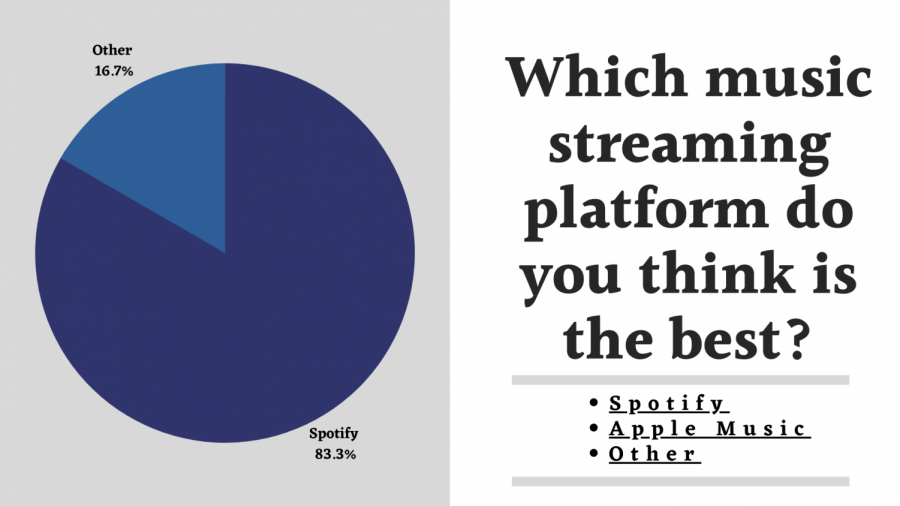Spotify vs. Apple Music: Head to Head
A graphical representation of the results from a recent survey which asked C.H.S students which music streaming platform they believed was best.
December 17, 2020
With 2020 coming to an end, both Apple Music and Spotify have released to their users a “wrapped” option to view their most listened to artists, songs, and more. This has again sparked the well-known controversy between the two platforms, as user opinions have once again spread like wildfire across all social media platforms.
There are multiple music streaming platforms available out there, such as Soundcloud, Youtube Music, and more. While these platforms seem to stay quiet amongst the controversy, with only a small percentage of virtual music listeners, Spotify and Apple Music go head to head for the #1 streaming platform in the public’s eye. With the 72 million Apple Music users worldwide compared to the 124 million Spotify users, it seems obvious Spotify takes the lead in this one. Now the question still stands, despite the numbers, which one ultimately is better?
For this specific article, we turned to the C.H.S. community, as many students report being caught in the crossfire between strangers, friends, and even family. In a recent survey sent out to the student body, an astonishing 100% of those who responded used Spotify over any other music provider. Senior Julia Smith added that “I like that Spotify can be used across all platforms, not just Apple devices,” which adds a perfect view into the cons of Apple Music itself.
When comparing Apple Music and Spotify, a few specific things are important to look into and compare. Regarding price, both tie at a monthly subscription of $9.99. Turning to user flexibility, an important thing to note is that Apple Music is only available to Apple device owners, making it less accessible to a wide variety of listeners. Spotify also offers a free ad-supported tier to the platforms, making it accessible to listeners even without the premium subscription, which is something Apple falls far from.
Shifting from pricing and accessibility into focus on the library and music selection, Apple tops at a high of 60 million songs with Spotify following behind at 50 million. Both platforms offer easy access to song and album choices. Freshman Meredith Hendrix adds, “Apple Music makes it easy to search up songs and artists and your music/playlists. They also have music videos for some songs which is nice for people who don’t want to look them up on Youtube.” The feature of these music videos has also recently added more user activity with the app itself. Switching over to the idea of podcasts, however, they fall into a different situation, as Spotify listeners can listen in-app while, Apple users must switch over to the Apple app “podcasts.”
One of the top reasons these streaming devices are used is for the aspect of music discovery. Both Apple Music and Spotify create selections based on previous listening history. The service works by comparing your most listened and liked genres to different playlists and tunes, then making playlists based on what music recommendations would suit you. Apple Music and Spotify seem tied in the section, as each offers basic recommendations tailored the same way. However, Apple Music has a service named “beats radio” in-app, which lets you listen to in-time music hosted by real D.J.’s.
Lastly, there is a social aspect to both of these apps, since both of which let you follow friends. However, Spotify goes beyond, allowing you to see which song your friends are listening to in real-time. In some ways, this brings more attention to Spotify, as this feature has attracted quite a bit of attention recently.
If you’re looking into which streaming platform is best for you, it’s important to note the differences each lay on the table. Apple users might gravitate more towards Apple Music since it combines well with an Apple subscription. However, with the reviewed topics, it seems Spotify may take the top with its wide variety of services and worldwide user accessibility.
Julia Smith adds, “It’s just like arguing for or against a sports team. People like to defend what they like,” which does explain this debate.
In the end, both platforms have decisive differences and similarities, and it seems this controversy around the subject is more user formatted over human instinct. As for now, Spotify takes the lead in the competition and doesn’t plan to go anywhere soon.






